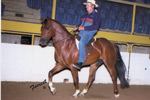
|
Return to Breed Profiles Main Page Virginia Single-footersTHEY GO BY different names. Virginia Pocket Horses, Virginia Speed Rackers, Virgina Single-footers. But go they do, and it is the "going" that has made them famous.
Many who raise these horses do not register them, though many do document their foals through NASHA or RHBAA. There are a variety of "types" due to the use of different broodmares crossed on a few stallions. Says Kay Stanley, breeder and aficionado, "There were some crosses with saddlebred mares, but mostly trotty standardbred mares. Most of the time it made a great smooth cross. If you have a pacey horse, it will always revert to a pace. If a trotty horse, it will go faster and longer in a rack or single-foot". Overall body type has been described as an "elegant, lean Moran, or modified Spanish" look, with short-coupled bodies and a naturally upright, arched head carriage. Size averages 14.2 to 15.2 hands. Buckskins were once common, tracing back to the dam of EZD FALCON ROWDY a cremello mare named MISTY, but bays, a few blacks, rare sorrels and liver chestnuts, even a couple of palominos, can now be found. Perhaps it is the Standardbred blood that accounts for both the speed in gait and the toughness of character common to these horses. Virginia Single-footers are known to be spirited. "The name Rowdy, I suspect, was no accident," comments historian and owner Craig Stripling. Indeed, they are not a horse for everyone. "Though any horse does better when ridden regularly, these horses just get better and better the more they are ridden," he explains.
Stanley also stresses the caliber of the mares used to outcross. "The EZD in Falcon Rowdy's name stood for Easy (for the horse) Demetris (for his owner, rider and breeder John Demetris) because he was such a smooth, fast ride. But you also need a good, or better mare than the stallion, to have a good baby. In my opinion, bloodlines don't mean anything if the horse isn't a good ride or a strongly gaited one. You can have a horse with perfect bloodlines and it not be any good in gait. Then breed that average, or less than average, mare to a good stud and get a so-so baby, then wonder why it wasn't as good as it's grandparents." She admonishes, "Strong gaited parents on both sides make strong gaited babies." |

 There are other bloodlines of fast racking horses in Virginia, but the line from THE COLONEL is the one most commonly referred to as the Virginia Pocket Horse, etc. His son, EZD FALCON ROWDY, (See Winter 2001) won acclaim as the Flatshod World Speed Racking Champion - twice. Speed did not muddy his gait, as his beat was as true at 30 miles per hour as it was at 15. With only a few generations of his get on the ground, it is with a sense of rare privilege that we examine a "breed" yet to be declared as such.
There are other bloodlines of fast racking horses in Virginia, but the line from THE COLONEL is the one most commonly referred to as the Virginia Pocket Horse, etc. His son, EZD FALCON ROWDY, (See Winter 2001) won acclaim as the Flatshod World Speed Racking Champion - twice. Speed did not muddy his gait, as his beat was as true at 30 miles per hour as it was at 15. With only a few generations of his get on the ground, it is with a sense of rare privilege that we examine a "breed" yet to be declared as such.  Kay Stanley describes them as "Energetic and wanting to go and go, with big motors and big hearts." She concedes, "They take a lot of work and wet saddle pads because their motors are so big." She describes the gait as, "A fast rolling lick in the front, and smooth. Once you see that fast rolling lick you can pick out a Rowdy horse, usually. Very seldom does a colt come out not with the lick"
Kay Stanley describes them as "Energetic and wanting to go and go, with big motors and big hearts." She concedes, "They take a lot of work and wet saddle pads because their motors are so big." She describes the gait as, "A fast rolling lick in the front, and smooth. Once you see that fast rolling lick you can pick out a Rowdy horse, usually. Very seldom does a colt come out not with the lick"